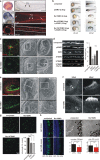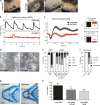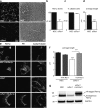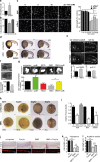Rer1p maintains ciliary length and signaling by regulating γ-secretase activity and Foxj1a levels
- PMID: 23479743
- PMCID: PMC3601348
- DOI: 10.1083/jcb.201208175
Rer1p maintains ciliary length and signaling by regulating γ-secretase activity and Foxj1a levels
Abstract
Cilia project from the surface of most vertebrate cells and are important for several physiological and developmental processes. Ciliary defects are linked to a variety of human diseases, named ciliopathies, underscoring the importance of understanding signaling pathways involved in cilia formation and maintenance. In this paper, we identified Rer1p as the first endoplasmic reticulum/cis-Golgi-localized membrane protein involved in ciliogenesis. Rer1p, a protein quality control receptor, was highly expressed in zebrafish ciliated organs and regulated ciliary structure and function. Both in zebrafish and mammalian cells, loss of Rer1p resulted in the shortening of cilium and impairment of its motile or sensory function, which was reflected by hearing, vision, and left-right asymmetry defects as well as decreased Hedgehog signaling. We further demonstrate that Rer1p depletion reduced ciliary length and function by increasing γ-secretase complex assembly and activity and, consequently, enhancing Notch signaling as well as reducing Foxj1a expression.
Figures





Similar articles
-
Rer1p competes with APH-1 for binding to nicastrin and regulates gamma-secretase complex assembly in the early secretory pathway.J Cell Biol. 2007 Feb 26;176(5):629-40. doi: 10.1083/jcb.200609180. J Cell Biol. 2007. PMID: 17325205 Free PMC article.
-
Wnt/β-catenin signaling directly regulates Foxj1 expression and ciliogenesis in zebrafish Kupffer's vesicle.Development. 2012 Feb;139(3):514-24. doi: 10.1242/dev.071746. Epub 2011 Dec 21. Development. 2012. PMID: 22190638 Free PMC article.
-
Notch/Her12 signalling modulates, motile/immotile cilia ratio downstream of Foxj1a in zebrafish left-right organizer.Elife. 2017 Sep 6;6:e25165. doi: 10.7554/eLife.25165. Elife. 2017. PMID: 28875937 Free PMC article.
-
Proton myo-inositol cotransporter is a novel γ-secretase associated protein that regulates Aβ production without affecting Notch cleavage.FEBS J. 2015 Sep;282(17):3438-51. doi: 10.1111/febs.13353. Epub 2015 Jul 14. FEBS J. 2015. PMID: 26094765 Review.
-
γ-Secretase-regulated signaling typified by Notch signaling in the immune system.Curr Stem Cell Res Ther. 2013 Sep;8(5):341-56. doi: 10.2174/1574888x113089990054. Curr Stem Cell Res Ther. 2013. PMID: 23957936 Review.
Cited by
-
Ciliary Beating Compartmentalizes Cerebrospinal Fluid Flow in the Brain and Regulates Ventricular Development.Curr Biol. 2019 Jan 21;29(2):229-241.e6. doi: 10.1016/j.cub.2018.11.059. Epub 2019 Jan 3. Curr Biol. 2019. PMID: 30612902 Free PMC article.
-
Generation of multiciliated cells in functional airway epithelia from human induced pluripotent stem cells.Proc Natl Acad Sci U S A. 2014 Apr 29;111(17):E1723-30. doi: 10.1073/pnas.1403470111. Epub 2014 Mar 24. Proc Natl Acad Sci U S A. 2014. PMID: 24706852 Free PMC article.
-
Zebrafish--on the move towards ophthalmological research.Eye (Lond). 2014 Apr;28(4):367-80. doi: 10.1038/eye.2014.19. Epub 2014 Feb 7. Eye (Lond). 2014. PMID: 24503724 Free PMC article. Review.
-
Ttyh1 regulates embryonic neural stem cell properties by enhancing the Notch signaling pathway.EMBO Rep. 2018 Nov;19(11):e45472. doi: 10.15252/embr.201745472. Epub 2018 Sep 3. EMBO Rep. 2018. PMID: 30177553 Free PMC article.
-
Rer1p regulates the ER retention of immature rhodopsin and modulates its intracellular trafficking.Sci Rep. 2014 Aug 6;4:5973. doi: 10.1038/srep05973. Sci Rep. 2014. PMID: 25096327 Free PMC article.
References
Publication types
MeSH terms
Substances
Grants and funding
LinkOut - more resources
Full Text Sources
Other Literature Sources
Molecular Biology Databases

